By Gregg A. Wilhelm
Photos by Will Kirk
Used wisely, information technology–in the form of “nursing informatics”–has the potential to transform nursing practice and patient care. At the Johns Hopkins University School of Nursing, faculty are leading the way to produce “technology-enabled” nursing professionals.
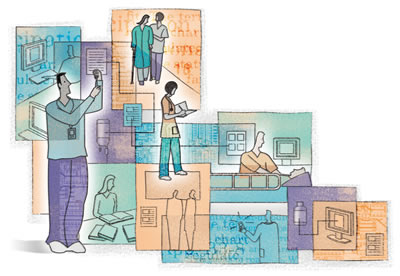
On the morning of August 29, 2005, Hurricane Katrina bore down on the Gulf Coast with 125-plus mile an hour winds and record storm surges. On its way to becoming the most destructive natural disaster in United States history, Katrina pushed through the levees of New Orleans and wreaked havoc on the city. In the wake of the devastation, there is a story of two hospital systems and the difference technology can make.
The paper-based medical record system at Charity Hospital, the United States’ largest hospital for the indigent, was nearly a total loss. By contrast, the Veterans Administration system in New Orleans restored its approximately 100,000 electronic data records within 24 hours from an off-site server that is part of the hospital’s disaster preparedness plan.
“Among the patients Charity had to ship elsewhere were a large number of disadvantaged children who were undergoing very complex oncology treatments,” notes Patricia Abbott, PhD, RN, FAAN, FACMI. “Almost all of their data was lost. The hospitals that received the transferred children could not recreate the paper records and treatment protocols, they had little idea what sort of treatment was being administered, and they could not reach the care teams in New Orleans due to displacement and lack of communication channels. We are left wondering how many children suffered as a result of not being able to quickly get them back into their therapeutic regimens.”
If records had been stored electronically, thousands could have been transmitted to any number of other hospitals wherever particular patients wound up. According to Abbott, many patients suffered and many died as a result of a lack of medical records. At the Johns Hopkins University School of Nursing, she has made it her mission to use information technology to help avoid such catastrophes in the future.
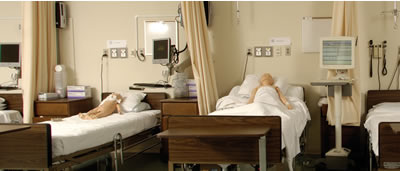
A pioneer in the field of “nursing informatics,” Abbott is leading efforts within the school to infuse the curriculum with the latest in technology and information science. An assistant professor, she holds a joint appointment with the Johns Hopkins University School of Medicine, sits on the board of the American Medical Informatics Association, and is co-director of the WHO/PAHO Collaborating Center for Nursing Knowledge, Information Management and Sharing at the school.
Abbott’s efforts took a major leap last November, with the opening of a grant supported Health care Information Technology (HIT) clinical lab at the school. The lab affords students hands-on experience in using the latest in information technology, as well as a means for testing its impact on nursing practice.
These initiatives at the school come at a time when the federal government is pushing to implement more health care information technology. In 2004, President George W. Bush named a national health information “czar” and issued an executive order to convert health records to electronic format for most Americans within 10 years. More recently, the Wired for Health Care Quality Act (passed by the Senate in November) would fund efforts to bring advanced HIT to the nation’s struggling health care system.
There’s more to health care information technology than electronic record-keeping. One key component of HIT is the Computerized Provider Order Entry (CPOE) system, now being used by many hospitals across the country, including Johns Hopkins. Used via bedside computer terminals, these systems digitally gather all patient data in one place, easily accessible to all doctors, nurses, and health care providers. The goal: to reduce medical errors and improve patient safety, and shorten patients’ hospital stays. CPOE systems can signal alerts if an order seems contrary to the evidence-base, and circumvent mistakes resulting from matters as simple as poor penmanship, misplaced decimal points, or information entered on the wrong patient.
In addition to CPOEs, there are countless other ways that health care information technology is having an impact. Text paging from nursing stations directly to doctors increases the accuracy and timeliness of responses. Subscription-based, accredited Internet sites provide the latest information on diseases and medications. Internal, network-based resources provide physicians and nurses with information about pharmacology services and patient care, or explain procedures for collecting laboratory specimens. Clinical decision support systems used during the ordering and documentation processes bring knowledge right to the point of care, at the moment of need, to assist providers in making higher quality and more efficient decisions.
Students graduating from the Johns Hopkins University School of Nursing walk directly into this new “wired” world, and they need to hit the ground running. Says Patricia Abbott, “You are either part of the future, or you are history. Our nursing educational system is adapting to this new reality.”
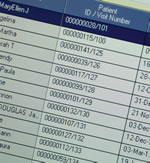
Many years ago, health care providers looked at the newly forming field of clinical information technology (informatics) and realized that nursing science was being overlooked. When the Institute of Medicine published To Err is Human(2000) and Crossing the Quality Chasm (2001), which promoted the use of technology to reduce errors in clinical settings, the focus was on physicians and informaticians.
The nursing perspective was ignored, says Marion Ball, EdD, professor at the School of Nursing and fellow in IBM’s Global Leadership Initiative. “Nurses are the foot soldiers at the forefront of patient safety and health care quality,” says Ball. “Ninety percent of errors are caught by nurses.”
Ball was among a group of indi-viduals who realized that input from nurses was fundamental to the success of any widespread implementation of HIT. This group—comprised of nurse advocates from industry, education, nursing organizations, and government-met in January 2005 to bridge the “quality chasm” in health care by improving the use of technology in nursing. They dubbed themselves the “TIGER” Team: Technology Informatics Guiding Educational Reform. The team’s platform is built on the Institute of Medicine’s premise in Health Professions Education: A Bridge to Quality(2003) that incorporating informatics into health care practice is a core competency for professionals today, but one that many nurses lack.
“Our goal is not to create ‘nurse informaticians,’ but technology-enabled nursing professionals,” says Ball, who recently completed the third edition of Introduction to Nursing Informatics in the Health Informatics Series, published by Springer-Verlag.
| “To send a nurse into practice without any information technology skills is a failure to comprehensively educate that nurse.”—Patricia Abbott |
Learning such core competencies needs to start in nursing school, says Abbott. “To send a nurse into practice without any information technology skills is a failure to comprehensively educate that nurse.” Pointing to HIT systems, she notes: “It is critical that we structure what a nurse does in a format that a computer can store, manipulate, and report on because major decisions are being made based on data spun out of these clinical systems. If nursing data is invisible, then nursing is invisible.”
Abbott sees a precedent for the school’s plans to thoroughly incorporate informatics in education. “When I first started in nursing school, ‘nursing research’ was a three-credit class. It was this separate little class on the side,” she says. “Now ‘nursing research’ is threaded through every course in the curriculum. This is the direction that informatics must take. It is an inherent part of nursing practice. It should not be viewed as independent and isolated.”
At the Johns Hopkins University School of Nursing, such efforts are well under way. For example, in the graduate-level Health Policy course, students explore how informatics influences public policy. In ethics and research classes, Johns Hopkins nursing students are taught not only how to utilize large collections of data from patient care information systems when conducting research, but how to do so ethically.
“Most of us are familiar with regulations regarding medical privacy,” Abbott says, “but we read nightmare stories about hackers who get into data that they shouldn’t. It’s a sensitive issue, so we are working to help our students understand the trade-offs between using such data for the common good of society while protecting the individual. We need our students to understand that, as future providers, they balance on the edge of a razor.”

Increasingly, says Abbott, school faculty from a variety of specialties are requesting help in tailoring their courses to incorporate nursing informatics.
Although informatics has begun taking root in the classroom, one vital component remained elusive—a hands-on clinical lab instructing students on real HIT systems. “Teaching informatics without a laboratory for hands-on learning is like trying to teach someone to play the piano by reading a book,” explains Abbott.
The concept came to fruition last November 28, with the launch of the Hopkins/Eclipsys Health care Information Technology lab. The lab was made possible by a $2.6 million Educational Grant by Eclipsys Corporation, a Florida-based service provider that developed one of the industry’s more widely used HIT in the Johns Hopkins Hospital, easing the transition for Hopkins School of Nursing students who migrate into staff positions.
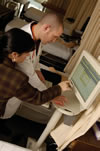
Set up like hospital wards, the skills lab includes approximately 13 beds. Each bed represents a “station” where students gather in groups of two or four with teaching assistants to learn and apply nursing skills on “simulation patients.”
Students log into the electronic health care record that exists for each simulated patient directly at the bedside. They check the plan of care and determine if the action they are about to take is prudent and safe. After students take their readings or administer a medication, they proceed to a wall-mounted computer workstation running Eclipsys Sunrise Clinical Manager to record their findings. This data is then available for the next “shift,” or set of students, who practice skills on another “patient” and enter that data. Students compare their findings to see if the patient’s condition has changed, initiate additional assessments, and alter plans of care.
The lab takes into consideration the nature of today’s nursing environment: Patients are sicker, health care providers struggle with a severe shortage of nurses, and medical errors are on the rise. “Things that should fly up at you as red flags may not,” says clinical instructor Krysia Hudson, MS, RNC, who, along with Abbott, was among the first cohort of students in the United States to earn a master’s degree in nursing informatics. “Somewhere, somebody, or something has to be there to remind you. We are using the HIT simulation labs to expose our students to such experiences.”
Hudson worked with the Eclipsys team to develop the initial modules for the student simulations. Because the system is designed for a real-world environment, there was considerable work that had to be completed to modify it for an educational situation. The huge undertaking involved pairing every piece of documentation to a corresponding order.
| “Students learn what a normal wound looks like, but when presented with a list of various adjectives…all of a sudden defining what that wound looks like is a whole lot harder. In the real world, there is no ‘normal,’ there are shades of gray.”—Krysia Hudson |
What excites Hudson is that the lab environment fosters critical thinking. “Students learn what a normal wound looks like,” she says, “but when presented with a list of various adjectives—sero-sanguinous, hemorrhaging, granulating—all of a sudden defining what that wound looks like is a whole lot harder. In the real world, there is no ‘normal,’ there are shades of gray.”
As an assistant in the Principles and Application class where the HIT system is heavily used, student Alice Elkin believes that the implementation of IT in clinical settings is crucial, and concurs with Hudson that the Eclipsys lab facilitates critical thinking and more careful documentation.
The system guides users through steps in a logical, easy-to-follow manner, Elkin says. The intuitive nature of such systems is especially important in nursing, a field in which both precision and efficiency are vital. Elkin has found that students in the lab are eager to help each other, which reduces the time required to grow familiar with the technology.
As with any technology, the Eclipsys system is only as “intelligent” as the humans behind its creation. So for its investment, Eclipsys gains access to substantial intellectual capital toward the ongoing design of its HIT system.
“The School of Nursing can serve as a testing ground for us,” says Jim Cato, vice president and chief nursing officer at Eclipsys and president-elect of the American Nursing Informatics Association. “The clinical lab setting provides us the opportunity to seek the input of experienced nurses and students seeking graduate degrees as we further develop our solutions or build new prototypes.”
|
|---|
“My main interest is to have developers of systems like Eclipsys sit with clinicians and explore what about the design allows people to make errors and how we can better design the system to eliminate those errors,” Abbott says. “This is where our graduate students and faculty can have the greatest impact. They will critique the impact that the system has on a variety of dimensions in the patient care process. We can in turn feed this information back to system developers to improve the systems that providers are being asked to use. Furthermore, this lab opens the doors to the study of HIT impact on the patient care team. In the future, we will bring in physicians, librarians, and other allied health professionals so we can study the impact of HIT on the entire health care team.”
Having orchestrated the successful launch of the IT clinical lab, Abbott is eager to turn research around quickly to impact the quality and safety of patient care.
“In five years, informatics is going to be part and parcel of nursing education and that fact just has to be,” she says. “There’s no escaping the future and this school of nursing is out in front of that curve.”
Marik Moen, RN (’03), contributed to this article.
 Online Clinical Course
Online Clinical Course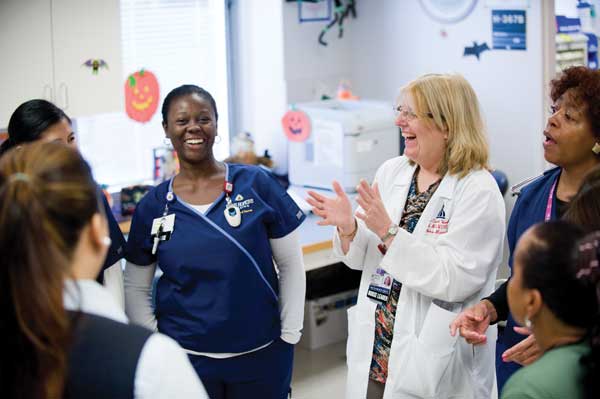 Lifelong Learning
Lifelong Learning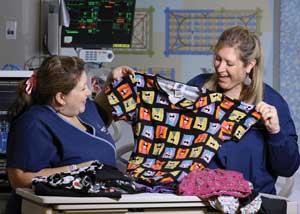 A Zest for Learning
A Zest for Learning Pancreas Enzyme Replacement Therapy
Pancreas Enzyme Replacement Therapy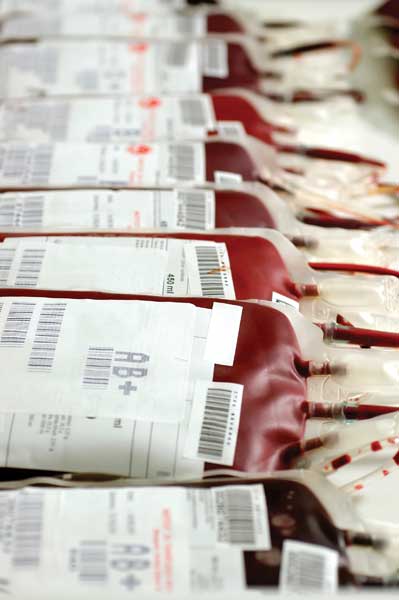 Blood Transfusion Reactions: What Nurses Need to Know
Blood Transfusion Reactions: What Nurses Need to Know







